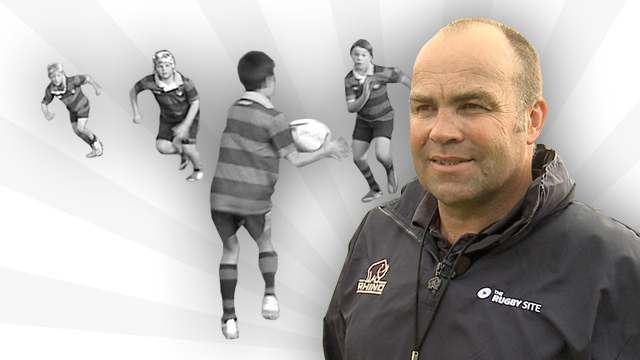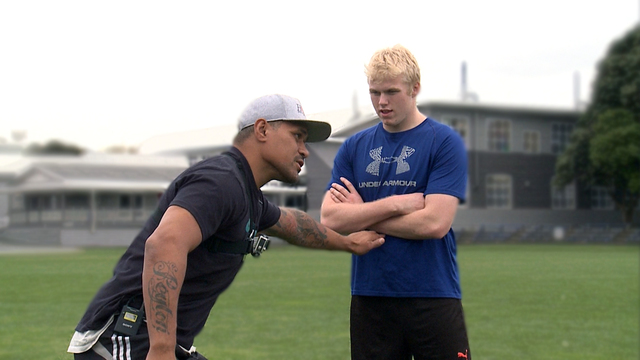Chopping them down to size
The tone of high-level rugby matches if typically established by what happens in the early physical exchanges – at the set-piece and in the collisions or close tackling situations. This is the place where team plants its flag physically and leaves its first imprint on the opponent.
Wayne Smith’s coaching module on the chop or cut tackle is an important aid in leaving that imprint. Four critical points emerge from his 23 minute session:
• Quick realignment in order to square up on the ball-carrier and meet him behind the advantage line
• Use of a “sharp line” to overlap shoulders with the attacker and achieve that squared-up posture
• Creating problematic ball-placement for the attacker on the ground
• Isolating the ball-carrier and creating opportunities for the jackal
One of the most impressive Test match defences close to the breakdown in recent times has belonged to Wales. In the shape of their #6 Dan Lydiate Wales have had a chop tackler of the highest quality, and they have used him opposite the opponent’s (forward) first receiver to create opportunities for turnovers from their two excellent ‘jackals’, #1 Gethin Jenkins and #7 Sam Warburton.
Let’s take a look at how Lydiate’s technique works in practice. The following two examples come from the opening period of Wales’ 2014 autumn match against the touring South Africans.
In the first of these two sequences, Dan Lydiate heads straight upfield to make the tackle on South Africa’s Francois Louw, meeting him about half a metre shy of the advantage line. His shoulders are fully-overlapped with Louw’s and the tackle itself is executed below knee level.
Lydiate’s position on the ground after the tackle is made also creates a problem or co-ordination for the cleanout players in support. #4 Eben Etzebeth has to step over and around Lydiate in order to clean out Gethin Jenkins, and he only just makes it before the ball is lost!
In the second example at 10:20, Lydiate has to work harder to achieve ‘overlapping shoulders’ on Tendai Mtawarira, shifting sideways before planting for the tackle at 10:21. Once again he drives right through the lower body below knee level and creates a positive target for Jenkins’ jackal. The first cleanout player, #8 Duane Vermeulen, has to step back and around the tackle area in order to remove Jenkins – and he has to use a more passive ‘body roll’ method to do it. Jenkins is well past the ball and must have come close to winning a penalty on this occasion.
The complete package can be observed in the following sequence from Wales’ tour of South Africa just a few months earlier:
As the Springbok ball-carrier (Gurthro Steenkamp) receives the pass, Lydiate is already squared-up and meets him fully two metres behind the advantage line. He drives his body right through the lower half of Steenkamp’s body, and as a consequence Steenkamp loses control of his ability to place the ball accurately before Gethin Jenkins is upon him. South Africa’s #19 Lood de Jager has to skirt around Lydiate in order to get to the cleanout, and this delay gives Jenkins the moment he needs to establish himself in a winning position above the tackle ball and effect the turnover.
The enduring effectiveness of the chop tackle technique was reinforced in last weekend’s match between the All Blacks and Argentina, with the Pumas’ Javier Ortega Desio making the tackle and Pablo Matera stealing the ball:
At 14:31 Desio extricates himself from the previous tackle and shuffles laterally in order to overlap shoulders with the All Black ball-carrier (#6 Liam Squire). He is able to meet him right on the advantage line as a result and effect the chop tackle. With Squire tumbling over the top of Desio, he does not have time enough to place the ball away from his body before Matera has locked on over the top of him to win the penalty. The replay from behind the posts clearly shows the difficulty the first cleanout player (#3 Owen Franks) has in skirting around the tackler and delivering an effective shot on Matera:
Franks has to shift to the right to avoid Desio – who is in a perfectly legal position on the ground – and can only hook Matera’s left arm. That is insufficient to remove the jackal and prevent the turnover.
Summary
The chop or cut tackle remains one of the most effective defensive devices, particularly against heavy ball-carries close to the previous breakdown. It is a great way of leaving that early physical imprint on the opponent!
The tackler must realign quickly from the previous phase of play in order to ‘overlap shoulders’ and square up on the ball-carrier as Wayne Smith indicates in his module. The tackle itself is executed at or below the knee and should drive right through the ball-carrier’s lower body as in the technique used by Dan Lydiate.
Accurate execution will likely mean a loss of control in the placement of the ball for the attacker, difficulty of approach for the cleanout support players and increased exposure to the jackal following up behind the tackler.






















